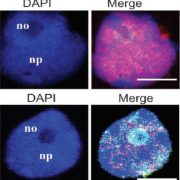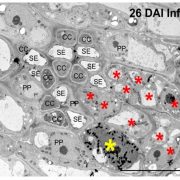
Taproot S3E1: Changing the Shape of Microbes and Mentoring
Blog, The Taproot Season 3, The-Taproot0 Comments
/
This season we are busting myths, and in this episode, we discuss the myth that mentoring is a one-way street. We talk with our guest Beronda Montgomery, Ph.D., about a cyanobacterium that changes shape in response to stress, and how mentors and trainees also need to change in response to their mutual…

Recognizing Plant Physiology first authors: Lisa-Marie Schmid
Plant Physiology, Plant Physiology: Author ProfilesLisa-Marie Schmid, first author of PUMPKIN, the sole Plastid UMP Kinase, Associates with Group II Introns and Alters Their Metabolism
Current Position: PhD student in the group of PD Dr. Jörg Meurer, Leister lab, Ludwig-Maximilians-University, München, Germany
Education: B.Sc. Biology and M.Sc.…

Worming into the Plant Chromatin: A Nematode Effector Influences Host Histone Acetylation
Blog, The Plant CellPlants encounter myriad invaders, including bacteria, fungi, insects, and other parasites. These pathogens generally deliver effector proteins into plants, increasing their virulence and targeting various host processes (Toruño et al., 2016). Although advances in the past two decades have led to significant…

Sugar architect: the Brassicaceae pathogen Clubroot manipulates plants on multiple levels to secure sucrose supply
The Plant Cell, The Plant Cell: In BriefThe soil-borne pathogen Plasmodiophora brassicae can infect most members of the Brassicaceae family. The infections, which can lead to extensive crop losses, typically involve development of galls in the underground tissues of the plant, giving the pathogen its common name, ‘clubroot’.
Although…

Setting and Diffusing the Cyanide Bomb in Plant Defense
Blog, Plant Physiology, Plant Physiology: News and ViewsHydrogen cyanide (HCN) is a potent inhibitor of cytochrome c oxidase, a conserved component of the respiratory electron transport chain in all aerobic life. Thus, HCN is well suited to serve as a broad-spectrum chemical defense, and indeed it plays such a role in many interactions between plants and…

Autophagy and Chloroplast Quality Control: Fatty Acid Synthesis Counts
Plant Physiology, Plant Physiology: News and ViewsPlants devote more than 70% of their available nitrogen to maintaining chloroplast function (Makino and Osmond, 1991). During senescence or under stress conditions, chloroplasts are degraded and their constituent components are recycled. Chloroplasts can be degraded through at least three pathways: (1)…

Scientists reveal the mechanism of mRNA polyadenylation in auxin and plant development
Blog, Plant Physiology
(Translated from the Chinese original)
Auxin is an important plant hormone that is essential for plant growth and development. At present, people's understanding of auxin signal transduction mainly focuses on the process of auxin receptor TIR1/AFBs- mediated Aux/IAAs protein degradation…

